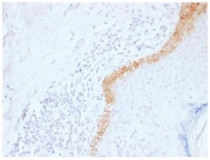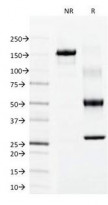ARG62526
anti-Cytokeratin 15 antibody [LHK15]
anti-Cytokeratin 15 antibody [LHK15] for Flow cytometry,ICC/IF,IHC-Formalin-fixed paraffin-embedded sections,SDS-PAGE,Western blot and Human,Mouse,Rat,Cow
Signaling Transduction antibody
Overview
| Product Description | Mouse Monoclonal antibody [LHK15] recognizes Cytokeratin 15 |
|---|---|
| Tested Reactivity | Hu, Ms, Rat, Cow |
| Tested Application | FACS, ICC/IF, IHC-P, SDS-PAGE, WB |
| Host | Mouse |
| Clonality | Monoclonal |
| Clone | LHK15 |
| Isotype | IgG2a, kappa |
| Target Name | Cytokeratin 15 |
| Antigen Species | Human |
| Immunogen | A 17-mer synthetic peptide from the C-terminus of Human Cytokeratin 15. |
| Conjugation | Un-conjugated |
| Alternate Names | CK-15; K15; Keratin, type I cytoskeletal 15; Cytokeratin-15; Keratin-15; K1CO; CK15 |
Application Instructions
| Application Suggestion |
|
||||||||||||
|---|---|---|---|---|---|---|---|---|---|---|---|---|---|
| Application Note | IHC-P: Antigen Retrieval: Boil tissue section in 10mM Citrate buffer (pH 6.0) for 10-20 min. * The dilutions indicate recommended starting dilutions and the optimal dilutions or concentrations should be determined by the scientist. |
Properties
| Form | Liquid |
|---|---|
| Buffer | PBS, 1% BSA and 0.05% Sodium azide |
| Preservative | 0.05% Sodium azide |
| Stabilizer | 1% BSA |
| Concentration | 0.2 mg/ml |
| Storage Instruction | For continuous use, store undiluted antibody at 2-8°C for up to a week. For long-term storage, aliquot and store at -20°C or below. Storage in frost free freezers is not recommended. Avoid repeated freeze/thaw cycles. Suggest spin the vial prior to opening. The antibody solution should be gently mixed before use. |
| Note | For laboratory research only, not for drug, diagnostic or other use. |
Bioinformation
| Database Links | |
|---|---|
| Gene Symbol | KRT15 |
| Gene Full Name | keratin 15, type I |
| Background | The protein encoded by this gene is a member of the keratin gene family. The keratins are intermediate filament proteins responsible for the structural integrity of epithelial cells and are subdivided into cytokeratins and hair keratins. Most of the type I cytokeratins consist of acidic proteins which are arranged in pairs of heterotypic keratin chains and are clustered in a region on chromosome 17q21.2. [provided by RefSeq, Jul 2008] |
| Research Area | Signaling Transduction antibody |
| Calculated MW | 49 kDa |
Images (2) Click the Picture to Zoom In
-
ARG62526 anti-Cytokeratin 15 antibody [LHK15] IHC-P image
Immunohistochemistry: Formalin-fixed and paraffin-embedded Human skin stained with ARG62526 anti-Cytokeratin 15 antibody [LHK15]. Antigen Retrieval: Boil tissue section in 10mM Citrate buffer (pH 6.0) for 10-20 min.
-
ARG62526 anti-Cytokeratin 15 antibody [LHK15] SDS-PAGE image
SDS-PAGE: Analysis of ARG62526 anti-Cytokeratin 15 antibody [LHK15] under non-reducing or reducing conditions.
Clone References









